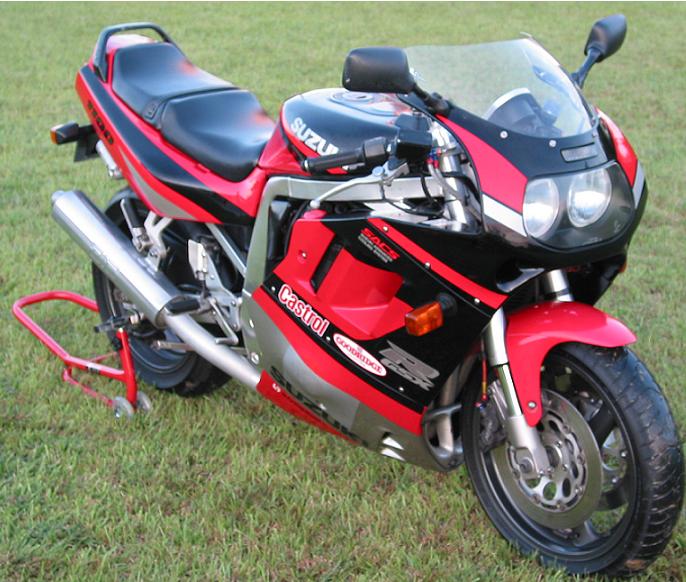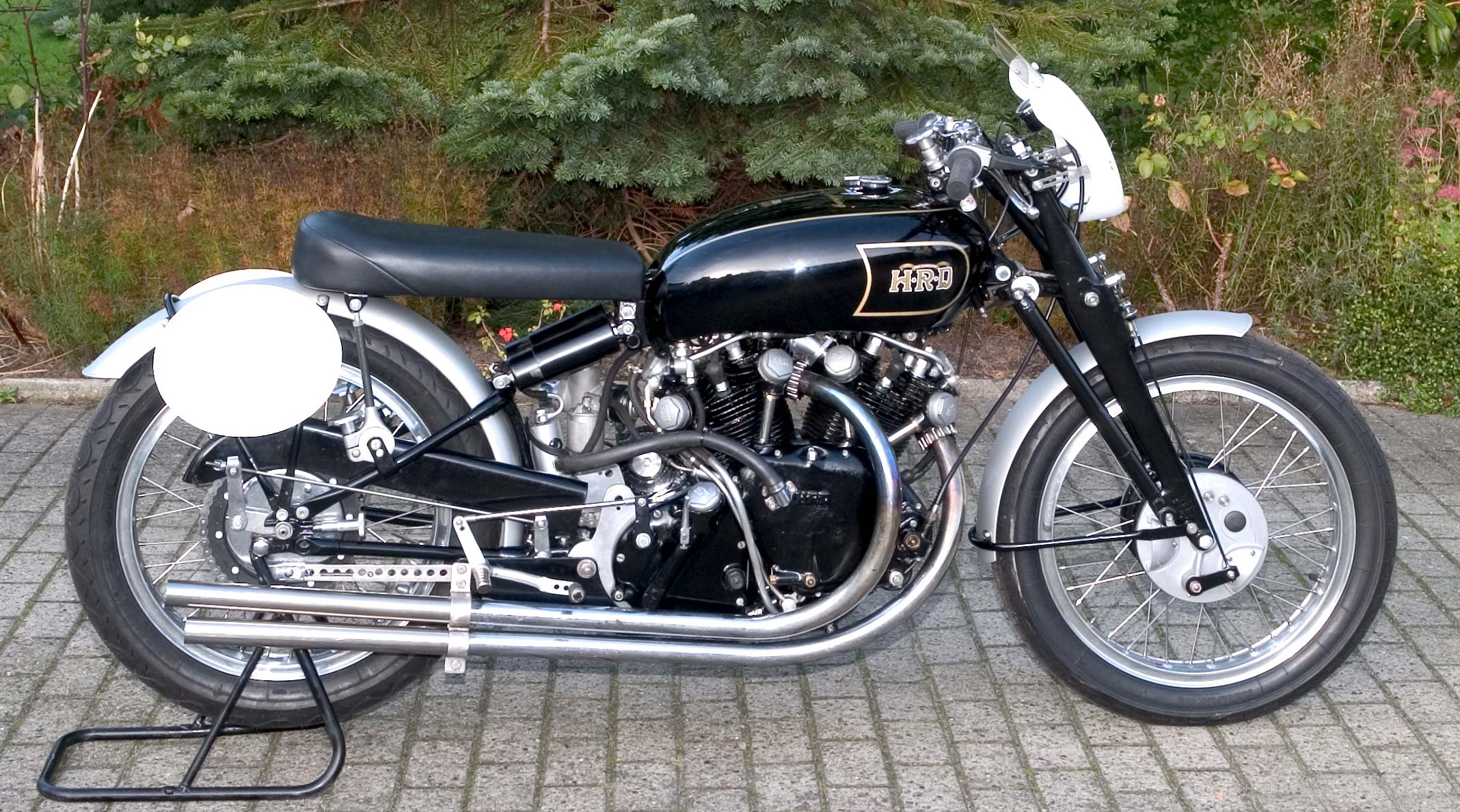|
Suzuki GSX-R1100
The Suzuki GSX-R1100 is a sport bike from Suzuki's GSX-R series of motorcycles produced from 1986 until 1998. Background In the mid 1970s, the motorcycle industry was in a period of transition. Noise and pollution concerns lead to large two-stroke motorcycles being banned from the streets in many countries. There were no purpose-built four-stroke sport bikes, most of which were derivatives of regular motorcycles. Those built by Japanese manufacturers were built around an in-line four-cylinder, air-cooled engine wrapped in a steel double cradle frame, most of which were similar enough that they became known as the Universal Japanese Motorcycle (UJM). Seeing an unfulfilled market position, Suzuki - which had made its reputation by building two strokes - built its first large four-stroke bikes: the dual overhead camshaft (DOHC) GS750 and the GS400 for the American market in 1976 (see: Suzuki GS series). The GS550 arrived soon after and by 1978 the formidable GS1000 were impressing ... [...More Info...] [...Related Items...] OR: [Wikipedia] [Google] [Baidu] |
Suzuki GS Series
The Suzuki GS series was Suzuki Motor Corporation's first full range of 4-stroke powered road motorcycles, having previously almost exclusively manufactured 2-stroke machines. Suzuki had produced the 4-stroke Colleda COX 125cc and 93cc 4-stroke single-cylinder machines in 1955 however the rest of Suzuki's production from 1952 to 1976 had been increasingly sophisticated two-stroke road machines, whose ultimate expression was the 750cc 3-cylinder water-cooled GT750. First models The first of the GS Series was the four-cylinder GS750 released alongside the GS400 parallel twin in November 1976. (1977 Model Year). The GS750 engine was essentially patterned off the Kawasaki Z1-900, and became the design basis for all air-cooled Suzuki four-stroke fours until the release of the air-oil cooled GSX-R. The GS750 engine was fitted into a dual cradle frame with telescopic forks, twin rear shocks and a front disc brake. The new GS750 was lauded for its handling at the time of its release, ... [...More Info...] [...Related Items...] OR: [Wikipedia] [Google] [Baidu] |
Phil Mellor
Glyn Philip Mellor (Phil 'Mez' Mellor, died 7 June 1989) was a Yorkshire-based English motorcycle racer. His career included racing on both road and race circuits. Mellor, from Shelley, near Huddersfield, West Yorkshire, died after an accident at Doran's Bend during the 1989 TT races on the Isle of Man. His race results included the 1984 TT Formula 2 Championship aboard a Yamaha 350, 125cc Gold Star 1981 Championship aboard a Honda, 1300cc Production 1986 British championship on a Suzuki, back to back 750cc Production championships in 1986 and 1987 for Suzuki, 1979 British 250cc Championship, Avon Roadrunner Production 500cc championship on a Yamaha 350 and back to back Honda 125cc championship victories in 1980 and 1981. Road race results included three wins, seven podiums and a total of 34 appearances at the Isle of Man TT. He also competed at the NW200, Ulster GP, won the 1978 Newcomers Lightweight Manx Grand Prix and scored a fifth place at Macau. The popular Yorkshi ... [...More Info...] [...Related Items...] OR: [Wikipedia] [Google] [Baidu] |
Honda Fireblade
The Honda Fireblade is a family of sport motorcycles manufactured by Honda since 1992. The first model was designed by Tadao Baba. * CBR900RR, 1992–1995 ** CBR919RR, 1996–1999 ** CBR929RR, 2000–2001 ** CBR954RR, 2002–2003 * CBR1000RR The Honda CBR1000RR, marketed in some countries as the "Fireblade" (capitalized as FireBlade until the 2000s), is a Radiator (engine cooling), liquid-cooled Inline-four engine, inline four-cylinder superbike, introduced by Honda in 2004 as the 7t ..., 2004–2019 ** CBR1000RR-R, 2020–present {{Set index article Set index articles on vehicles Fireblade Sport bikes ... [...More Info...] [...Related Items...] OR: [Wikipedia] [Google] [Baidu] |
Tadao Baba
is a retired Japanese motorcycle engineer, the original designer of the Honda Fireblade. Career Baba joined Honda Motorcycles from high school in 1962, aged 18 — the company itself was only 14 years old. Working in the machinery section, he made crankcases and cylinder heads for Honda’s Honda CB72 and Honda CB77. At age 20, Baba moved to Honda's R&D department, which is where he spent the rest of his career until retiring in 2004. He continued as a consultant until 2009. Total Control In the late 1980s, sports motorcycles were very fast, with magazines rating bikes on their top speed. To house a 1000cc engine the bikes became heavy, while to ensure the stability of the bikes at high speed, the chassis became longer. The result was a series of fast bikes, which didn't handle in corners. Baba states this as the reason which inspired him to design the FireBlade: Baba began developing a new concept in sports motorcycles under the title "Total Control," based on the fundamentals ... [...More Info...] [...Related Items...] OR: [Wikipedia] [Google] [Baidu] |
Tariff
A tariff is a tax imposed by the government of a country or by a supranational union on imports or exports of goods. Besides being a source of revenue for the government, import duties can also be a form of regulation of foreign trade and policy that taxes foreign products to encourage or safeguard domestic industry. ''Protective tariffs'' are among the most widely used instruments of protectionism, along with import quotas and export quotas and other non-tariff barriers to trade. Tariffs can be fixed (a constant sum per unit of imported goods or a percentage of the price) or variable (the amount varies according to the price). Taxing imports means people are less likely to buy them as they become more expensive. The intention is that they buy local products instead, boosting their country's economy. Tariffs therefore provide an incentive to develop production and replace imports with domestic products. Tariffs are meant to reduce pressure from foreign competition and reduce th ... [...More Info...] [...Related Items...] OR: [Wikipedia] [Google] [Baidu] |
Suzuki Advanced Cooling System
The Suzuki Advanced Cooling System (SACS) was developed by Suzuki engineer Etsuo Yokouchi in the early 1980s. The system was used extensively on GSXR model bikes from 1985 through 1992. Suzuki continued to use the system in its GSF (Bandit) and GSX (GSX-F, GSX1400, Inazuma) lines until the 2006 model-year and DR650 from 1990 to present. Engines using the SACS system were generally regarded as being very durable. Development While addressing reliability issues in Suzuki's only turbo charged bike, the XN85, the SACS system was first conceived by Etsuo Yokouchi, who looked to World War II–era aircraft for inspiration. Like air-cooled motorcycles, radial engines used in many early aircraft suffered from heat and reliability issues. To overcome these problems, aircraft engineers often used oil jets aimed at the bottom of an engine's pistons to carry away excess heat. Following their example, Yokouchi decided to apply the approach to motorcycles A motorcycle (motorbike, b ... [...More Info...] [...Related Items...] OR: [Wikipedia] [Google] [Baidu] |
Suspension (motorcycle)
A motorcycle's suspension serves a dual purpose: contributing to the vehicle's handling and braking, and providing safety and comfort by keeping the vehicle's passengers comfortably isolated from road noise, bumps and vibrations. The typical motorcycle has a pair of fork tubes for the front suspension, and a swingarm with one or two shock absorbers for the rear suspension. Front suspension The most common form of front suspension for a modern motorcycle is the telescopic fork. Other fork designs are girder forks, suspended on sprung parallel links (not common since the 1940s) and bottom leading link designs, not common since the 1960s. Some manufacturers (e.g. Greeves) used a version of the swinging arm for front suspension on their motocross designs. A single-sided version of the idea is also used in motor scooters such as the Vespa. The hub-center steering as developed by Ascanio Rodorigo, on a concept associated to Massimo Tamburini is a complex front swingarm alternat ... [...More Info...] [...Related Items...] OR: [Wikipedia] [Google] [Baidu] |
New Old Stock
New old stock (NOS), or old stock for short, refers to aged stock of merchandise that was never sold to a customer and still new in original packaging. Such merchandise may not be manufactured anymore, and the new old stock may represent the only current source of a particular item. retrieved on 2008-10-20. There is no consensus on how old a product must be to be NOS, and some people reserve an NOS label only for products that are actually discontinued. Although not an officially recognized accounting term, it is in common use in the and industries. For example, owners of classic, vintage, and antique vehicles s ... [...More Info...] [...Related Items...] OR: [Wikipedia] [Google] [Baidu] |
Yamaha Motor Company
is a Japanese multinational manufacturer of motorcycles, marine products such as boats and outboard motors, and other motorized products. The company was established in 1955 upon separation from Yamaha Corporation (however, Yamaha Corporation is still the largest private company shareholder with 9.92%, as of 2019), and is headquartered in Iwata, Shizuoka, Japan. The company conducts development, production and marketing operations through 109 consolidated subsidiaries as of 2012. Led by Genichi Kawakami, the company's founder and first president, Yamaha Motor spun off from musical instrument manufacturer Yamaha Corporation in 1955 and began production of its first product, the YA-1 125cc motorcycle. It was quickly successful and won the 3rd Mount Fuji Ascent Race in its class. The company's products include motorcycles, scooters, motorized bicycles, boats, sail boats, personal water craft, swimming pools, utility boats, fishing boats, outboard motors, 4-wheel ATVs, recreat ... [...More Info...] [...Related Items...] OR: [Wikipedia] [Google] [Baidu] |
Kawasaki GPZ900R Ninja
The Kawasaki GPZ900R (also known as the ZX900A or Ninja 900) is a motorcycle that was manufactured by Kawasaki from 1984 to 2003. It is the earliest member of the Ninja family of sport bikes. The 1984 GPZ900R (or ZX900A-1) was a revolutionary design that became the immediate predecessor of the modern-day sport bike. Developed in secret over six years, it was Kawasaki's and the world's first 16-valve liquid-cooled inline four-cylinder motorcycle engine.Walker (2006) p. 172 The 908 cc four-cylinder engine delivered , allowing the bike to reach speeds of , making it the first stock road bike to exceed . Prior to its design, Kawasaki envisioned producing a sub-liter engine that would be the successor to the Z1. Although its steel frame, 16-inch front and 18-inch rear wheels, air suspension, and anti-dive forks were fairly standard at that time, the narrow, compact engine was mounted lower in the frame, allowing it to take Japanese superbike performance to a new level. Six mo ... [...More Info...] [...Related Items...] OR: [Wikipedia] [Google] [Baidu] |
Kawasaki Motorcycles
Kawasaki motorcycles are manufactured by the Motorcycle & Engine division of Kawasaki Heavy Industries. History Kawasaki Aircraft initially manufactured motorcycles under the Meguro name, having bought an ailing motorcycle manufacturer, Meguro Manufacturing with whom they had been in partnership. This eventually became Kawasaki Motor Sales. Some early motorcycles display an emblem with "Kawasaki Aircraft" on the fuel tank. During 1962, Kawasaki engineers were developing a four-stroke engine for small cars. Then some of the engineers transferred to the Meguro factory to work on the Meguro K1 and the SG, a single cylinder 250 cc OHV. In 1963, Kawasaki and Meguro merged to form Kawasaki Motorcycle Co.,Ltd. Kawasaki motorcycles from 1962 through 1967 used an emblem which can be described as a flag within a wing. Work continued on the Meguro K1, a copy of the BSA A7 500 cc vertical twin. and on the Kawasaki W1. The K2 was exported to the U.S. for a test in respons ... [...More Info...] [...Related Items...] OR: [Wikipedia] [Google] [Baidu] |


.png)



